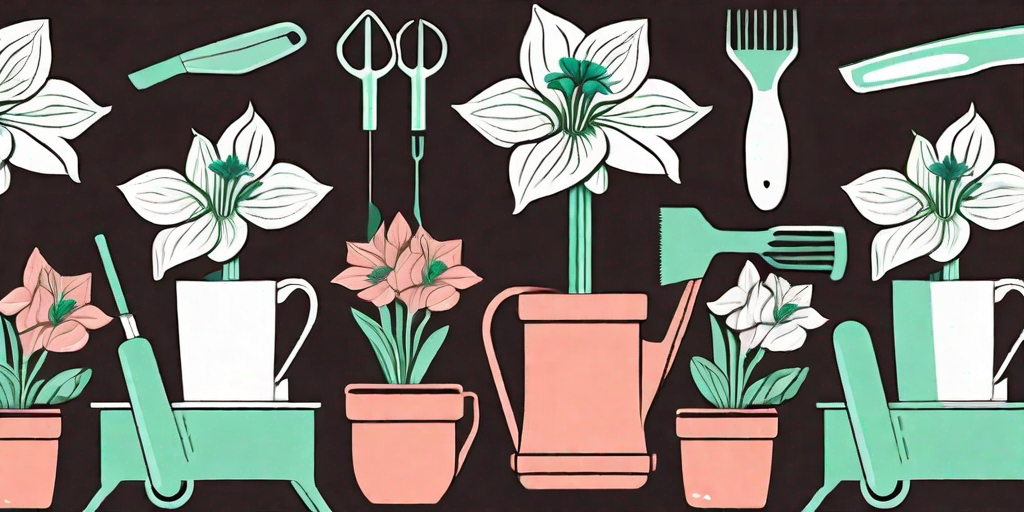
Whether you're a seasoned gardener or a newbie who can't tell a weed from a flower, the Amaryllis is a delightful plant that can bring a splash of color to your home or garden. This bulbous plant, with its vibrant, trumpet-shaped flowers, is a joy to behold and surprisingly easy to care for. So, buckle up and get ready to embark on a journey of Amaryllis care that's as easy as pie.
Understanding the Amaryllis
Before we dive into the nitty-gritty of Amaryllis care, let's take a moment to understand this beautiful plant. The Amaryllis, or Hippeastrum, is a tropical plant native to South America. It's a perennial flowering plant, which means it can bloom year after year if cared for correctly. The flowers are large and colorful, making them a popular choice for indoor and outdoor gardens.
There are over 90 species of Amaryllis, each with its unique charm. The most common colors are red and orange, but you can also find them in pink, white, salmon, and even multicolored varieties. So, whether you're a fan of the classic red or want to experiment with something more exotic, there's an Amaryllis for everyone.
Planting Your Amaryllis
Now that we've got to know our plant a little better, let's get down to business. Planting an Amaryllis is a straightforward process, even for those of us who struggle to keep a cactus alive.
First, you'll need to choose a pot that's about twice the diameter of your bulb. Fill the pot halfway with a well-draining potting mix, place the bulb in the center, and fill the rest of the pot, leaving the top third of the bulb exposed. Water thoroughly and place the pot in a warm, bright spot. And voila! You've just planted your Amaryllis.
Best Time to Plant
The best time to plant your Amaryllis depends on when you want it to bloom. If you're aiming for a Christmas bloom, plant your bulb in early November. For a New Year's bloom, plant in early December. And if you're not fussed about when it blooms, any time between October and April will do just fine.
Choosing the Right Pot
Choosing the right pot for your Amaryllis is crucial. A pot that's too small can constrict the bulb and hinder growth, while a pot that's too large can lead to overwatering and root rot. As a rule of thumb, choose a pot that's about 1 to 2 inches larger in diameter than your bulb.
Caring for Your Amaryllis
Caring for an Amaryllis is a breeze. These plants are not fussy and require minimal care to thrive. However, there are a few things you should keep in mind to ensure your Amaryllis blooms successfully.
Watering
Amaryllis plants prefer to be kept on the dry side, so it's important not to overwater them. Water thoroughly once the top inch of soil feels dry to the touch, and make sure the pot drains well to prevent waterlogging. Remember, when it comes to watering, less is more.
Light and Temperature
Amaryllis plants love light and warmth. Place your pot in a bright spot, but avoid direct sunlight as it can scorch the leaves. As for temperature, Amaryllis prefer a range of 70-75°F during the growing season and 55-60°F during dormancy.
Fertilizing
While Amaryllis are not heavy feeders, a little fertilizer can go a long way in promoting healthy growth and vibrant blooms. Use a balanced, water-soluble fertilizer every 2-3 weeks during the growing season.
Common Amaryllis Problems and Solutions
While Amaryllis are generally easy to care for, they can sometimes run into problems. But don't worry, we've got you covered.
Bulb Rot
Bulb rot is a common problem caused by overwatering. If your bulb is soft and mushy, it's likely suffering from rot. To save your plant, remove the rotten parts of the bulb, let it dry out, and replant in fresh, well-draining soil.
Leaf Yellowing
If the leaves of your Amaryllis are turning yellow, it could be a sign of overwatering or lack of nutrients. Cut back on watering and consider using a balanced fertilizer to address any nutrient deficiencies.
FAQs
- How often should I water my Amaryllis?
- Water your Amaryllis when the top inch of soil feels dry to the touch. Be careful not to overwater as this can lead to bulb rot.
- Can I grow Amaryllis outdoors?
- Yes, Amaryllis can be grown outdoors in USDA zones 8-10. In colder climates, they can be grown outdoors in summer and brought indoors in winter.
- Why isn't my Amaryllis blooming?
- There could be several reasons why your Amaryllis isn't blooming. It could be due to insufficient light, overwatering, or lack of nutrients. Make sure your plant is getting enough light, cut back on watering, and consider using a balanced fertilizer.
So there you have it, folks. Amaryllis care made easy. With these tips and tricks, you'll be on your way to blooming success in no time. And remember, whether you're a green thumb or not, anyone can grow a beautiful Amaryllis. Happy gardening!















